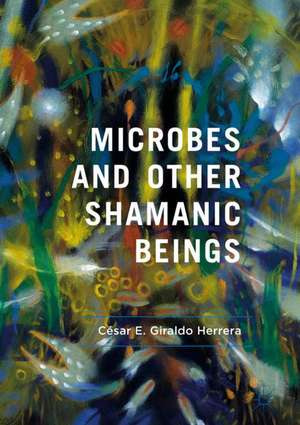Microbes and Other Shamanic Beings
Autor César E. Giraldo Herreraen Limba Engleză Hardback – 20 mar 2018
Shamanism is commonly understood through reference to spirits and souls. However, these terms were introduced by Christian missionaries as part of the colonial effort of conversion. So, rather than trying to comprehend shamanism through medieval European concepts, this book examines it through ideas that started developing in the West after encountering Amerindian shamans. Microbes and Other Shamanic Beings develops three major arguments: First, since their earliest accounts Amerindian shamanic notions have had more in common with current microbial ecology than with Christian religious beliefs. Second, the human senses allow the unaided perception of the microbial world; for example, entoptic vision allows one to see microscopic objects flowing through the retina and shamans employ techniques that enhance precisely these kinds of perception. Lastly, the theory that some diseases are produced by living agents acquired through contagion was proposed right after Contact in relation to syphilis, an important subject of pre-Contact Amerindian medicine and mythology, which was treasured and translated by European physicians. Despite these early translations, the West took four centuries to rediscover germs and bring microbiology into mainstream science.
Giraldo Herrera reclaims this knowledge and lays the fundaments for an ethnomicrobiology. It will appeal to anyone curious about shamanism and willing to take it seriously and to those enquiring about the microbiome, our relations with microbes and the long history behind them.
| Toate formatele și edițiile | Preț | Express |
|---|---|---|
| Paperback (1) | 778.94 lei 6-8 săpt. | |
| Springer International Publishing – 28 dec 2018 | 778.94 lei 6-8 săpt. | |
| Hardback (1) | 784.13 lei 6-8 săpt. | |
| Springer International Publishing – 20 mar 2018 | 784.13 lei 6-8 săpt. |
Preț: 784.13 lei
Preț vechi: 956.26 lei
-18% Nou
Puncte Express: 1176
Preț estimativ în valută:
150.05€ • 160.45$ • 125.10£
150.05€ • 160.45$ • 125.10£
Carte tipărită la comandă
Livrare economică 18 aprilie-02 mai
Preluare comenzi: 021 569.72.76
Specificații
ISBN-13: 9783319713175
ISBN-10: 3319713175
Pagini: 242
Ilustrații: XX, 274 p.
Dimensiuni: 148 x 210 mm
Greutate: 0.5 kg
Ediția:1st ed. 2018
Editura: Springer International Publishing
Colecția Palgrave Macmillan
Locul publicării:Cham, Switzerland
ISBN-10: 3319713175
Pagini: 242
Ilustrații: XX, 274 p.
Dimensiuni: 148 x 210 mm
Greutate: 0.5 kg
Ediția:1st ed. 2018
Editura: Springer International Publishing
Colecția Palgrave Macmillan
Locul publicării:Cham, Switzerland
Cuprins
1. Colonising and decolonising ontologies.- Part 1: Amerindian shamanism.- 2. (Mis)Understanding shamanism and animism.- 3. First contacts with Amerindian shamans and their “spirits”.- 4. Syncretic ontologies of the microbial-masters of game.- Part 2: Shamanic microscopy, perceiving cellular souls and microbial spirits.- 5. Shamanic epistemologies.- 6. Neuropsychological naturalistic explanations of shamanic visions.- 7. The cavern of the eye: seeing through the retina.- 8. Entoptic microscopy.- Part 3: Biosocial Ethnohistory of Syphilis and Related Diseases.- 9. French malaise in the Taíno myths of origin.- 10. The spotted Sun and the blemished Moon, Nahuatl views on treponematoses.- 11. The West, Syphilis and the other treponematoses.- 12. Threading worlds together.
Recenzii
“In this book, and related publications, he makes excellent use of a sweep of literature about Caribbean and Lowland South American Amerindians as well as about medicine, epidemiology, and biology.” (Graham Harvey, Body and Religion, Vol. 3 (1), 2019)
“The book impresses by the breadth of its scope, the diverse literature it builds on, and the innovative bridges it establishes with research areas that have often been off-putting to social anthropologists. The hypothesis it explores is bold and imaginative, and it most certainly adds a new voice to microbial anthropology.” (Germain Meuelemans, Anthropological Notebooks, Vol. 25 (1), 2019)
“The book impresses by the breadth of its scope, the diverse literature it builds on, and the innovative bridges it establishes with research areas that have often been off-putting to social anthropologists. The hypothesis it explores is bold and imaginative, and it most certainly adds a new voice to microbial anthropology.” (Germain Meuelemans, Anthropological Notebooks, Vol. 25 (1), 2019)
Notă biografică
César E. Giraldo Herrera, biologist and social anthropologist, is the Victoria Maltby Junior Research Fellow at Somerville College and an Associate Researcher at the Institute for Science Innovation and Society (InSIS), School of Anthropology and Museum Ethnography (SAME), University of Oxford, UK.
Textul de pe ultima copertă
Shamanism is commonly understood through reference to spirits and souls. However, these terms were introduced by Christian missionaries as part of the colonial effort of conversion. So, rather than trying to comprehend shamanism through medieval European concepts, this book examines it through ideas that started developing in the West after encountering Amerindian shamans. Microbes and other Shamanic Beings develops three major arguments: First, since their earliest accounts Amerindian shamanic notions have had more in common with current microbial ecology than with Christian religious beliefs. Second, the human senses allow the unaided perception of the microbial world; for example, entoptic vision allows one to see microscopic objects flowing through the retina and shamans employ techniques that enhance precisely these kinds of perception. Lastly, the theory that some diseases are produced by living agents acquired through contagion was proposed right after Contact in relation to syphilis, an important subject of pre-Contact Amerindian medicine and mythology, which was treasured and translated by European physicians. Despite these early translations, the West took four centuries to rediscover germs and bring microbiology into mainstream science. Giraldo Herrera reclaims this knowledge and lays the fundaments for an ethnomicrobiology. It will appeal to anyone curious about shamanism and willing to take it seriously and to those enquiring about the microbiome, our relations with microbes and the long history behind them.
Caracteristici
Innovatively brings together microbiology and Amerindian shamanic practice, with a view to interrogating both as equals Intertwines biocultural and ethnohistorical approaches Provides a fresh comparative exploration sure to be of interest to anthropologists, historians and social scientists of medicine, science, and biology
